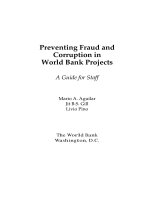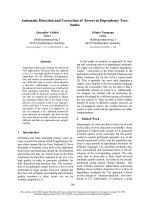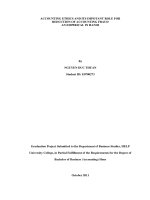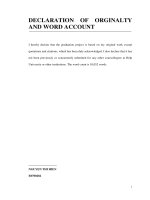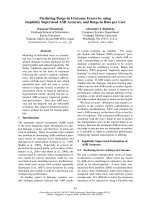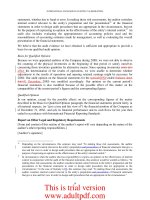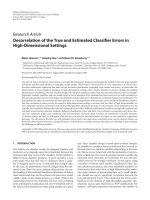fraud and errors in auditing financial statements
Bạn đang xem bản rút gọn của tài liệu. Xem và tải ngay bản đầy đủ của tài liệu tại đây (588.66 KB, 55 trang )
FRAUD AND ERRORS IN AUDITING FINANCIAL
STATEMENTS
BY
CAN MAI HUONG
E0700241
BACHELOR OF BUSINESS (ACCOUNTING) HONS
HELP UNIVERSITY COLLEGE
OCTOBER, 2011
FRAUD AND ERRORS IN AUDITING FINANCIAL
STATEMENTS
BY
CAN MAI HUONG
E0700241
Graduation Project Submitted to the Department of Business Studies, HELP
University College, in Partial Fulfilment of the Requirements for the Degree of
Bachelor of Business (Accounting) Hons
OCTOBER, 2011
- Page II -
Declaration of Originality and Word count
DECLARATION
I here by declare that this graduation project is based on my original work except for
quotations and citation that have been duly acknowledged. I also declare that it has
not been previously or concurrently submitted for any other courses/degrees at HELP
University College or other institutions. The word Count is words.
Can Mai Huong
October, 2011
- Page III -
Acknowledgements
This project would not have been made possible without the assistance, support and
encouragement of many people. I wish to take this opportunity to thank all the people
who have helped me during the time of completing the dissertation.
Firstly, I would like to express my deep gratitude to my supervisor at the
International School – Vietnam National University Ha Noi (ISVNU). He has kindly
helped me and supported me all the way through. For that, I am very grateful. I also
would like to express my thank to and at Help University College, who initiated the
project and give so much instruction and support.
In addition, a huge thank for all managers, accountants, personnel who sacrificed
theirs time to answers my questionnaire.
CAN MAI HUONG
- Page IV -
ABSTRACT
FRAUD AND ERRORS IN AUDITING FINANCIAL
STATEMENTS
BY
CAN MAI HUONG
OCTOBER, 2011
Supervisor: PHAM DUC HIEU
During the audit, there are always fraud and errors which are not detected and falsify
financial statements. To reduce the risk of undetected fraud affecting seriously the
financial statements and to express a right opinion on financial statements, auditors
need to concern about fraud problem and the possibility of fraud during the audit. In
fact, there is always a difference between the expectations of users of financial
statements expected from auditors and what auditors can meet. Because the user
thinks that auditors absolutely ensure honest and reasonable financial statements
while it is very difficult for auditors to do this. To narrow this gap, auditors have to
not only explain the limitations and scope of the auditing industry to users of
financial statements but also continuously improve the professional capacity of
individuals to find out our fraud and errors falsifying financial statements seriously.
- Page V -
Table of Contents
Declaration of Originality and Word count II
Acknowledgements III
ABSTRACT IV
Table of Figures VIII
List of Abbreviations IX
Chapter 1: INTRODUCTION 1
1.1 Research background 1
1.2 Problem statement 2
1.3 Research question 3
1.3.1 Fraud and Errors in the worlds 3
1.3.2 Fraud and Errors in Vietnam 5
1.3.3 Research statement 6
1.4 Thesis structure 7
Chapter 2: LITERATURE REVIEW 9
2.1 Definition of Fraud and Errors 9
2.1.1 Definition of Fraud 9
2.1.2 Definition of Errors 10
2.1.3 Compare Fraud and errors 10
2.2 The Forms of Fraud 11
2.2.1 Forms of fraud 11
2.2.2 Forms of errors 11
2.3 Factors affecting the fraud and errors 11
2.4 Related Theory 13
2.4.1 The Control Fraud Theory 13
2.4.2 The ―Fraud Created the Market‖ Theory 15
2.5 The common method to fraud in auditing financial statements 18
2.5.1 High declaration (or perjury) revenue 18
2.5.1 High declaration (or perjury) revenue 19
2.5.2 Note the year wrong 19
2.5.3 Conceal liabilities and expenses 19
2.5.4 Declare not enough information 19
- Page VI -
2.5.5 Apply underestimated method 19
2.6 Motive for fraud and errors in financial statements of enterprises. 20
Chapter 3 : RESEARCH METHODOLOGY 22
3.1 Research method 22
3.1.1 Quantitative methodology 22
3.1.2 Qualitative methodology 22
3.2 Data source 23
3.2.1 Secondary data 23
3.2.2 Primary data 23
3.3 Research tool 23
3.3.1 Internet tool 23
3.3.2 Questionnaire 24
Chapter 4: FINDING AND DISCUSSION 25
4.1 Questionnaire Results 25
4.1.1 Question 1: Among the following errors, please indicate types of errors that
you often see in auditing the Financial Statements? 25
4.1.2 Question 2: In your opinion, for which of the following reasons lead to act of
embezzlement? 26
4.1.3 Question 3: In your opinion, for which of the following reasons lead to fraud
on the Financial Statements? 27
4.1.4 Question 4: In your opinion, which sectors or fields often occur high risk fraud: 27
4.1.5 Question 5: You tell me about the person who implements fraud often holds
which position at the Company: 28
4.1.6 Question 6: In your opinion, in two age groups which groups often implement
fraud: 28
4.1.7 Question 7: During forms of revenue fraud, which the following form you
often face up to: 29
4.1.8 Question 8: In terms of business management, in your opinion, which factor
plays a decisive role in preventing the frauds in the financial statements? 30
4.2 Interview results 30
Chapter 5 : CONCLUSION AND RECOMMENDATION 35
5.1 Lessons for Vietnam 35
5.1.1 Enhance responsibilities of auditor for fraud and errors: 35
- Page VII -
5.1.2 Regularly update auditing standards including standards related to fraud and
errors: 35
5.1.3 Should release guidance on procedures for fraud detection 35
5.2 To raise the responsibility of auditors for fraud and errors in the audit of
financial statements 36
5.2.1 Ministry of Finance still performs a key role in releasing auditing standards: 37
5.2.2 Take legal proceedings against the whole organizations of Vietnam association
of accounting and auditing 38
5.2.3 Always update released auditing standards: 38
5.2.4 Should release detailed guidance 38
5.2.5 Attach special importance to human resource training to the regional level 39
5.3 Solutions for auditing companies 40
5.3.1 Strengthen controlling the internal quality of auditing companies 40
5.3.2 Strengthen procedures for detecting fraud in auditing program 40
5.3.3 Improve the training quality of auditors 40
5.4 Conclusion 41
APPENDICES 44
- Page VIII -
Table of Figures
Figure 1: compare between Fraud and Errors
Figure 2: Types of errors
Figure 3: Reasons lead to act of embezzlement
Figure 4: Reasons lead to fraud on the Financial Statements
Figure 5: Fields often occur high risk fraud
Figure 6: Person who implements fraud
Figure 7: Age groups often implement fraud
Figure 8: Forms of revenue fraud
Figure 9: Factor plays a decisive role in preventing the frauds
- Page IX -
List of Abbreviations
WTO: World Trading Organization
U.S: United Stated
BTCC: Bach Tuyet Cotton Corporation
A&C: Auditing and Consulting
ACCA: Association of Characted Certified Accountant
CEO: Chief Executive Officer
CFO: Chief Financial Officer
ACFE: Association of Certified Fraud Examiners
VACPA : Vietnam Association of Certified Public Accountants
ISA: International Standards on Auditing
KPMG: Klynveld Peat Marwick Goerdeler
E&Y: Ernst & Young
PwC: Price waterhouse Coopers
- Page 1 -
Chapter 1: INTRODUCTION
1.1 Research background
There always exist hidden fraud and errors causing mistakes to financial statements.
To reduce risks of not discovering frauds which seriously affect financial statements
and to give right opinions about financial statements, auditors need to study fraud
and ability of fraud appearance during audit process. In fact, there always exists
difference between expectation of financial statements readers in auditor and what in
fact auditors meet their expectation as readers know that auditors must ensure the
absolute honesty and reasonability, but auditors cannot do that. To address with this
problem, besides explaining the scope and limitation of audit sector, auditors must
incessantly improve their competence and professional knowledge to discover fraud
and errors causing essential errors to financial statements.
Within the framework of the market economy, the demand of information receipt and
delivery, especially financial data which always plays an important role in making
business decisions. The transparency, truthfulness of financial data plays a key role
in stabilizing the securities market and the society.
Recently, a lot of big financial frauds have occurred in the world, producing a stir in
world opinion. People are surprised about not only economic losses due to fraud but
also the methods of fraud implementation. Except for employees and senior leaders
of the company, independent auditors are also involved in implementing a fraud in
which Enron fraud is a typical example.
In Vietnam, many frauds have occurred on the Financial Statements in recent years.
The failure to detect fraud is caused by many reasons in which must include the
responsibilities of auditor and auditing company. Because independent auditing
profession in Vietnam has just started for over 15 years, this period isn’t long enough
to have a professional staff of auditors corresponding to the world level. In addition,
the legal environment for auditing sector is taking steps to build and gradually
complete; therefore, it’s still inadequate.
Hence, improve the quality of independent auditing activities, strengthen the
responsibility of auditor in respect of detecting fraud and errors on the Financial
Statements is still a topical question with a view of enhancing the transparency,
reliability of financial data in making economic decisions.
- Page 2 -
Therefore we should incessantly study fraud and errors in accounting and auditing.
To better understand such fraud and errors, I will present about the topic ―FRAUD
AND ERRORS IN AUDITING FINANCIAL STATEMENTS‖.
1.2 Problem statement
In order to better understand fraud and errors in auditing financial statements of
recent companies, we need to answer some following questions: What is fraud and
errors? In broad sense, fraud is illegal behaviors to cheat then to gain benefits.
There are three most common ways to make fraud, namely: appropriation,
defrauding and embezzlement.
In accounting aspect, according to international accounting standard No 10, fraud
and errors are defined as errors in calculation, in application of accounting policies,
unreal explanation, fraud or intentionally missing out.
In auditing aspect, according to international auditing standard No 240 in 2004,
fraud and errors are defined as follows:
Errors are non-intentional mistakes which affect financial statements such as missing
out an amount of money or not declaring information in financial statements.
Common examples about errors are errors during data collection and processing and
presenting it in financial statements, errors in accounting estimations, or application
of underestimated accounting principles.
The second question: Why are fraud and errors important in auditing financial
statement? In recent years, there have had much fraud in financial statements.
Inability to discover these frauds are due to many reasons including responsibility of
auditors and auditing companies. As the job as independent auditor has just been
present in Vietnam for more than 15 years, this time is not long enough for auditors
to have an international professionalism and competence. In addition, legal
environment for auditing sector has been step by step established and completed,
thus it still has many problems.
Therefore, improving quality of independent auditing activities and enhancing
responsibility of auditors in discovering fraud and errors in financial statements is a
topical question so as to improve transparency and reliability of financial information
in economic-related decision making. The thesis will focus on analyzing some
- Page 3 -
popular fraud in financial statements in the world and in Vietnam, then to propose
effective approaches for auditors to discover fraud and errors in auditing financial
statements. In addition, the thesis also combines with macro solution group to
complete legal corridor for auditing profession.
The third question: Influences of fraud and errors in auditing financial statements
for enterprises in Vietnam? In the market economy, demand of giving and receiving
information, especially financial information plays a highly important role in making
business decisions.
Transparency and honesty of financial information has great importance in
stabilizing securities market and society.
In recent years, there occur many financial frauds which produce a stir in world
opinion. People are not only surprised about economic detriments caused by fraud
but also ways of making fraud. People making fraud are not only staffs and senior
managers of companies but also independent auditors.
1.3 Research question
1.3.1 Fraud and Errors in the worlds
Fraud appears together with the appearance of human society. Together with the
development of the society, fraud is more and more sophisticated and shown in
various forms. Source of fraud is the transformation in which each individual from a
separate life starts to live into community. The embryonic form of fraud is the
embezzlement of property in order to satisfy personal demands.
Fraud develops together with the birth and development of the economy. In the
industrial revolution, there appeared a series of enterprises with the separation
between ownership and management function. This separation gave birth to a new
form of fraud which was fraud between managers, staffs and their owner.
Manifestation of this form of fraud was embezzlement of property. By 20
th
century,
rapid development of the world’s economy, especially the importance of securities
market – a most effective channel of capital mobilization of the world’s financial
market, lead to many new forms of fraud which are made by some members in board
of Directors of among staffs.
- Page 4 -
At the end of the 20
th
century, the bankruptcy of a series of world’s leading economic
groups brought about serious downturn of a whole sector. The society was once
surprised by a fact that there are more and more frauds in the society, in which the
most typical fraud at the end of 20
th
century were of Enron, Worlcom, Xerox, Nicor
Energy LLC.
Enron: In 1990s of the 20
th
century, Enron was one of world’s leading companies
doing business in energy. Its business had been highly efficient. However, at the end
of the 20
th
century, its business results were more and more declining. The late 6
months in 1999, the company’s profit was 325 million dollars while the late 6
months in 2000 its profit was just 55 million dollars. To maintain trust of the public,
Enron had exaggerated its profit in its financial statements. The fraud was not only
made by one person or some people but it was the collusion of many people
including members in the Board of Management. The group making fraud was the
Governance of the Company and even the auditing company. To hide its declining
business, the Company had some ways such as:
- Use methods evaluating assets and debts according to market price. If this
method is used, there will appear in financial statements ―virtual‖ income which
cannot be converted into money;
- Hide its debts and costs: To do this, Enron has established a series of child
companies which act as buyer and seller to so that it can hide its debt and loss.
Although the financial statements announced loans which were declining, in fact
during early 9 month in 2000 its debt due increased dramatically. During that time,
Enron had borrowed additional 3.9 billion dollars, raising total debt by September of
13 billion dollars; ratio of due debt over total working capital accounts for 50%, in
stead of 39% in 1999.
Besides high declaration of its income and concealing its expenses, Enron also on its
own initiatives change information about energy market in Texas, in California and
bribe Government of foreign countries in wining energy contract in foreign
countries.
Worldcom: In Mart 2002, this Company was accused of making fraud though
capitalization of an operating cost of 3.8 billion dollars and thus making up a
respective profit by U.S Securities and Exchange Commission, public prosecutor in
- Page 5 -
New York. In addition, there was an illegal fraud of its founder – Mr. Bernard Ebber
who had borrowed an amount of 400 million dollars which had not been recorded
and declared in its financial statements.
Xerox: In June 2000, U.S Securities and Exchange Commission accused Xerox of
declaring wrong information in its financial statements for 5 years, high declaring an
income of 1.5 billion dollars. To correct its fault, Xerox agreed to pay a fine of 10
million dollars for U.S Securities and Exchange Commission and re-prepared its
financial statements from the year 1997 honestly and transparently. Board of
Directors of the Company also committed to obey requirements of Securities Law
and ensure there would have no fraud and error in its financial statements.
Nicor Energy LLC: In July 2002, this Company made fraud in its financial
statements but the independent auditor had not discovered. Its fraud was mainly high
declaration of revenue and missing out costs. After that, Nicor Energy LLC adjusted
its financial statements and currently it has established a reliable accounting system.
Above fraud appeared in early the 21
st
century, this means that together with the
development of the economy, fraud techniques are more and more developed, more
sophisticated and made by collusion of many people. While before the year 2000,
fraud was mostly embezzlement made by some members in Board of Directors or
staff of company, in recent years there have emerged new forms of fraud which are
fraud in financial statements. People making fraud are not one person or some people
but a group of people including Board of Directors, Board of Management and
Auditing Companies. Adverse impacts of fraud are much greater and on many people
in the society.
1.3.2 Fraud and Errors in Vietnam
In recent years in Vietnam, a series of fraud in economy, commerce and financial
statements discovered have shown that fraud occurs in all form of enterprises: State-
owned enterprises, joint stock companies, private enterprises and in all sectors:
commerce, production, construction…Although these frauds are as not serious as in
other countries in the world, it exerts great influences on the economy and belief of
people in financial statements of companies, especially listed companies in securities
market. Typical examples of fraud in financial statements of listed companies are of
Bien Hoa Confectionery Corporation - Bibica, Bach Tuyet Cotton Corporation
- Page 6 -
(BTCC) ), Ha Long Canned Food Stock Corporation, etc. In addition, according to
statistics of Stox.vn
1
, by 20
th
April 2009, among 357 enterprises listed in securities
market, there have had at least 194 companies having disparity between results
before and after auditing, in which many enterprises have great disparity in business
results (more than 10%). And there have been 47 enterprises having difference in
business results before and after auditing of up to 50%.
Through fraud in financial statements of companies in recent time, we can conclude
their ways of making fraud as follows:
Companies have made up its revenue and income, and recorded decrease of costs.
Recording decrease of costs are often made through capitalization of cost, not full
depreciation of provisions, especially provisions for devaluation of financial
investment, provision for bad debts. Companies can also transfer some costs to next
year or change methods used in prime cost accounting, method of calculating
depreciation. For example, for Bibica, concealing its loss in financial statements in
2002 was made by recording 5,565 billion dong of business operation expense into
cost for construction in progress and making up income of 1,337 billion dong. Or for
financial statements of BBT, the company has not made depreciation for devaluation
of goods in stock, changed depreciation policies leading to decrease depreciation
expense of about 1,253 billion dong compared to that of 2004; not accounted product
advertisement expense which it has paid during the year.
Motive for fraud is because managers have to suffer from pressure in which they
have to reach a target about revenue, profit or company wants to maintain market
price of its shares while it is facing difficulties in business and financial state.
1.3.3 Research statement
According to Mr. Ho Van Tung, Manager of Auditing Division, Auditing and
Consulting Company Ltd (A&C): ―Auditing is a job which has many risks as when
Auditors give their opinions about financial statements which have been prepared
and presented by Board of Directors of the audited company, they can give wrong
opinions when there are fraud and errors in the financial statements which have not
1
Stox.vn – Intensive securities financial information. This is a website providing financial
information about all Vietnam’s enterprises listed in securities market.
- Page 7 -
been discovered. On the other hand, the pressure of completing a great volume of
work in short time easily make mistakes. Thus auditing is a challenging job for
auditors. Therefore, this job not only requires auditors to have sufficient knowledge
and skills in auditing and accounting, ability to supervise their work, ability to make
judgments and discover auditing risks, but they also need to have good
understanding about relevant regulations and law, have experiences and through
understanding about business activities of customers‖.
2
Vietnam is on the first phase of market economy. Vietnam’s auditing sector has been
operating for 20 years, but it is still quite young compared to other countries. Thus,
knowledge I have learnt in the subject ACCA
3
help me easily grasp changes in the
sector as well as new regulations about accounting and auditing. On the other hand,
knowledge and skills of the course also help me to improve professionalism in my job.
So why are fraud and errors important in auditing financial statements?
Influences of fraud and errors in auditing financial statements for Vietnam’s
enterprises?
In order to understand more about fraud and errors, this study will focus on fraud and
errors in auditing financial statements.
1.4 Thesis structure
The remainders of this research is organised as follow
Chapter 1: Introduction, conclusion, references and appendix.
Chapter 2 ―Literature review‖ starts with definition of fraud and errors in auditing
financial statements so that readers will have a general view about fraud and errors.
Some theories and researches related to fraud and errors concepts present through
different collections, summaries and discussion. Followed by parts: Forms of fraud
and errors, factor affecting fraud and errors, common ways to make fraud and errors
in financial statements, responsibilities of auditors for fraud and errors, relationship
2
Source: www.ftmsglobal.edu.vn
3
ACCA: (Association of Chartered Certified Accountants) is one of certificates issued by
Association of Chartered Certified Accountants of the U.K which is acknowledged and highly
appreciated in the world. ACCA is leading certificate in auditing – accounting – finance – banking in
the U.K and other developing countries in the world.
- Page 8 -
between fraud and errors and ethic issue. At the end of this chapter, I myself will
give some of hypothesises hereof.
Chapter 3: Research method is presented with different parties such as, data source,
research tools.
Chapter 4 : The results of research, my findings through the questionnaire are
available in the fourth chapter. This chapter also presents the limitation during the
research.
Finally, Chapter 5 will give some implication for Government and Enterprises and
eventually the conclusion of this research.
- Page 9 -
Chapter 2 : LITERATURE REVIEW
2.1 Definition of Fraud and Errors
2.1.1 Definition of Fraud
Fraud is behaviors which intentionally make mistakes to economic and financial
information implemented by many people in the organization or the third party,
exerting influences on audited subject.
In finance-accounting, fraud can simply be the behavior of intentionally violating
property, embezzling public funds, embezzlement and corruption, etc. Violating
property often attaches with distorting accounting information such as incorrectly
recording operations, faking or repairing vouchers, concealing documents and
covering up clue, etc.
For example: When checking the cutting down on sales revenue in some customers,
among selected operations, auditors have picked up an operation relating to revenue
from a customer; based on business evaluation of other auditing, the auditor
discovers that this customer is one main buyer. This operation is not often and
considered as being essential. Documents relating to this operation have been
collected, including evidence relating to payment of accounts receivable after the
closing date of financial statements of the year. However, document relating to
waterway delivery have not been given. After being analyzed, it proves that there is
no record about delivery process. Although there is evidence about payment, nothing
proves that goods had been delivered. So more analysis is done, auditor asks for
invoices of the company. Auditor has proved that some invoices for ―special
services‖ have been given to customer when they are paid. These invoices are less
detailed than other invoices in the document file and they cannot be clarified through
orders or documents receivable. These special invoices have shown that such sale
operation is absolutely doubtful. This problem is discussed with Financial Officer
who gives an incorrect explanation. After meeting Board of Management, the auditor
meets the Financial Officer again and informs that the problem is being investigated.
The Financial Officer has colluded with Managing Director to make plan to increase
sales so as to gain revenue target. As the Financial Officer wants to validate the
problem,, he chooses a main customer to involve in this. He will instruct directly the
customer to fill in the invoice and give it back within 30 days. After that he will
- Page 10 -
coordinate and ―make up‖ virtual sale to company of the customer with respective
amount of money. Within 30 days paying this virtual sale, the customer will defer the
payment. At the end of accounting period, this dishonest sale will be recorded in to
revenue. This helps the Financial Officer to reach sales target.
2.1.2 Definition of Errors
Errors are non-intentional mistakes influencing on financial statements such as
missing out an amount of money or not declaring information in financial statements.
Common examples about errors are ones in data collection and processing and its
presence in financial statements, errors in estimations or application of
underestimated accounting principles. Errors can be very serious such as violating
regulations about finance and accounting, repeated errors or errors of big
scale…however they are non-intentional.
2.1.3 Compare Fraud and errors
Similarity: Both of them are mistakes, causing misleading information and
reflecting incorrectly fact.
Difference:
Point of
comparison
Fraud
Errors
Form
- Fraud is intentional behavior
with careful calculation to gain
benefits.
- Errors are non-intentional
behavior; they are just simple
missing out information or due
to limited competence and
carelessness in working…
causing mistakes.
Sophisticati
on
- As fraud is intentional behavior,
it is more sophisticated than errors.
When making fraud, people are
often well-prepared and have
careful calculation, thus it is
difficult to detect fraud than errors.
- As errors are non-intentional
behavior, they are as not
sophisticated as fraud and it is
easy to detect errors.
Essence
- Fraud is always considered as
essential mistakes.
-Depends on scale and essence
of errors.
Figure 1: compare between Fraud and Errors
- Page 11 -
2.2 The Forms of Fraud
2.2.1 Forms of fraud
Distort, fake voucher and documents
Repair accounting vouchers and documents
Embezzle property
Conceal or intentionally miss out economic information, document or
operation
Record economic operation incorrectly
Intentionally apply underestimated accounting standards, principles, methods
and system, financial policies.
Intentionally make incorrect mathematic calculations
2.2.2 Forms of errors
Make mistakes in mathematic calculation or record wrongly
Miss out or wrongly understand economic operations
Apply underestimated accounting standards, principles, methods and system,
financial policies non-intentionally
2.3 Factors affecting the fraud and errors
Limitations in designing and performing internal control system
Existing limitations of auditing activities
Issues relating to probity or competence of Board of Directors, such as;
Management is controlled by a person or a group of people, lacks effective
supervision of Board of Directors or Board of Management.
Organizational structure of audited company is complicated intentionally
Powerless in overcoming shortcomings of internal controlling system while
such shortcomings can be absolutely overcome.
- Page 12 -
Frequently change chief accountant or responsible person in accounting and
finance division
Lack accounting staff in a long time
Arrange person who is not specialized in accounting or being restricted by
law to work as an accountant
Frequently change law consultant or auditor
Unusual pressure in the organization or from outside environment such as:
o It has difficulties in its fields of business
o Lack capital for doing business due to loss or too rapid expansion of company
scale
o Income declines
o Enterprise intentionally accounts increase in profit so as to magnify its
operation
o Too rapidly invest in new field of business or products which leads to
financial imbalance
o Enterprise is dependent on some products or some customers
o Financial pressure from investors or managing levels in the organization
o Pressure on staff to complete their work in short time
o Abnormal operations or economic events such as operations occur at the end
of accounting year have impacts on revenue, cost and results
o Complicated operations or accounting treatment methods
o Operations with related parties
o Costs are too high compared with provided services
Difficulties relate to sufficient collection of reasonable auditing evidence:
Accounting documents are insufficient or not provided promptly
Insufficient archive about economic events and operations.
- Page 13 -
Great discrepancy between accounting book of the organization with
confirmation of the third party, conflicts of auditing evidence, in ability to
explain changes of operating indicators.
Board of Directors refuses to explain or their explanations do not meet
auditor’s requirements
Factors from informatics environment relate to above situations and events
such as:
In ability to get information from computer
There are changes in computer programs but documents have not been
saved, approved and tested.
Information and documents printed from computer are not compatible
with information in financial statements.
Information and documents printed from computer are different each time
of printing.
2.4 Related Theory
2.4.1 The Control Fraud Theory
4
Control fraud theory was developed in the savings and loan debacle. It explained that
the person controlling the S&L (typically the CEO) posed a unique risk because he
could use it as a weapon.
The theory synthesized criminology (Wheeler and Rothman 1982), economics
(Akerlof 1970), accounting, law, finance, and political science. It explained how a
CEO optimized ―his‖ S&L as a weapon to loot creditors and shareholders. The
weapon of choice was accounting fraud. The company is the perpetrator and a
victim. Control frauds are optimal looters because the CEO has four unique
advantages. He uses his ability to hire and fire to suborn internal and external
controls and make them allies. Control frauds consistently get ―clean‖ opinions for
financial statements that show record profitability when the company is insolvent and
unprofitable. CEOs choose top-tier auditors. Their reputation helps deceive creditors
and shareholders.
4
Source:
- Page 14 -
Only the CEO can optimize the company for fraud. He has it invest in assets that
have no clear market value. Professionals evaluate such assets-allowing the CEO to
hire ones who will inflate values. Rapid growth (as in a Ponzi scheme) extends the
fraud and increases the ―take.‖ S&Ls optimized accounting fraud by loaning to
uncreditworthy and criminal borrowers (who promised to pay the highest rates and
fees because they did not intend to repay, but the promise sufficed for the auditors to
permit booking the profits). The CEO extends the fraud through ―sales‖ of the
troubled assets to ―straws‖ that transmute losses into profits. Accounting fraud
produced guaranteed record profits-and losses.
CEOs have the unique ability to convert company assets into personal funds through
normal corporate mechanisms. Accounting fraud causes stock prices to rise. The
CEO sells shares and profits. The successful CEO receives raises, bonuses, perks,
and options and gains in status and reputation. Audacious CEOs use political
contributions to influence the external environment to aid fraud by fending off the
regulators. Charitable contributions aid the firm’s legitimacy and the CEO’s status.
S&L CEOs were able to loot the assets of large, rapidly growing organizations for
many years. They used accounting fraud to mimic legitimate firms, and the markets
did not spot the fraud. The steps that maximized their accounting profits maximized
their losses, which dwarfed all other forms of property crimes combined.
While agreeing that the S&L served as both a ―weapon‖ and a ―shield,‖ control fraud
theory cast doubt on those metaphors. Weapons and shields are visible; fraud is
deceitful. The better metaphors would be camouflage, or a virus. Control fraud
theorists rejected the economists’ metaphor, ―gambling for resurrection‖ (honest but
unlucky risk takers). Gambling cannot explain why control fraud was invariably
present at the typical large failure. There were over 1,000 felony convictions of
senior S&L insiders. Accounting fraud made control fraud a sure thing-not a gamble.
Control fraud theory predicts the pattern of record profits and catastrophic failure and
the business pattern of deliberately making bad loans. Both patterns are inconsistent
with honest gambling.
- Page 15 -
2.4.2 The “Fraud Created the Market” Theory
5
In an August 16, 2010 opinion, the United States Court of Appeals for the Third
Circuit rejected use of the so-called ―fraud created the market‖ theory for securities
fraud claims. Malack v. BDO Seidman, LLP, No. 09-4475 (3d Cir. Aug. 16, 2010).
The ―fraud created the market‖ theory posits that a securities fraud plaintiff should
not have to prove individual reliance upon alleged misrepresentations if the plaintiff
can show that, absent the misrepresentations, the securities that the plaintiff
purchased would not have been offered for sale at all, on the premise that under such
circumstances the plaintiff’s reliance can be presumed. The Third Circuit’s ruling
adds to the split among the federal circuit courts of appeals on the viability of this
controversial theory, thus potentially presaging an eventual resolution of the issue by
the United States Supreme Court.
Background
The plaintiff in Malack had purchased notes issued by a subprime mortgage
originator. Those notes later became worthless after the decline of the subprime
mortgage sector. The plaintiff sued the accounting firm that allegedly provided clean
audit opinions that were used to obtain SEC registration of those notes, seeking
recovery on his own behalf as well as certification of a class of allegedly defrauded
purchasers of the notes.
The plaintiff did not allege that he had read, reviewed, or directly relied upon the
audit opinion that was the basis for his suit. Nor did he allege that the notes (which
did not trade on any securities exchange) traded in an ―efficient market,‖ such that
their price could be presumed to promptly reflect all relevant information available to
the investing public. Instead, in order to establish reliance upon the audit opinion,
the plaintiff alleged that ―without clean audit opinions, American Business would not
have been able to register the Notes with the SEC, the Notes would not have been
marketable, and Malack and the other investors would not have purchased the
Notes.‖
The United States District Court for the Eastern District of Pennsylvania denied class
certification, finding that Malack’s ―fraud created the market‖ theory lacked a legal
5
Source: www.chadbourne.com

